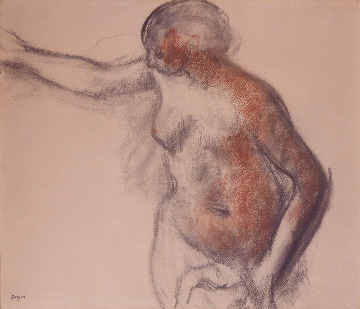Edgar DEGAS (1834-1917)
Femme nue debout vue à mi-corps
(Standing Nude From the Waist Up)

ca. 1891
Conte and red chalk on paper
43.0X 50.0 cm
vente stamp lower left: Degas
Gift of the Cultural Foundation of Okada
There are lovely anecdotes about Degas and photographs. Photography provided Degas, whose eyesight was beginning to fail, with a second set of eyes. In approaching his works, we should remember how fortunate it was that this artist, whose paintings demonstrate elements of classicism, encountered the new medium of photography. People often describe his works as "snapshot-like" without even reflecting, but it is easy to understand why people so often apply this description to his work.
Let's think for a moment about why his works feel like snapshots. First of all, the central images are often not finished. Second, they do not appear to have been drawn in an especially careful or deliberate way. Third, in the case of figure drawings, Degas consciously draws the models so that they are not facing the viewer. If these are the conditions for a "snapshot-like" photo, there are probably few people who argue that this particular work makes the grade.
However, it does not necessarily follow that if a work has these qualities they were indeed made as quickly as a snapshot. The artist captures the outlines of his subject. He adds shadow. He adds color. Because drawing involves so many steps, it requires a longer amount of time to create one than a photograph, which is captured by the momentary flick of a shutter. Since drawings take time, the artist is not just a simple reporter. He must do other things. He abbreviates. He describes. He digests the image and reproduces it in a way that expresses the plasticity of the subject.
In this work, Degas has added an extra step that further separates the drawing of the model from the finished work. He has transcribed the sketch using his own technique of transference. He dampened the original sketch, put a piece of paper of it, and then put it through a press to transfer it to the other sheet of paper. The main purpose of this was not to produce more copies and earn more money. No, Degas was interested in the mirror image that would result from transferring the picture. He was probably interested in the way that an image, when reversed, loses its original context and takes on possibilities of form that the creator had not necessarily imagined. Like a card player, Degas would hold onto his images until the right moment presented itself and he could then craft them into new stories.
An unexpected moment... A performance without preparation... The greatest appeal of snapshots is in their ability to capture such transitory moments. In an atelier in Paris, an artist captures an image of a nude woman wiping away a few drops of water on her leg. One can hardly restrain the urge to thrust a narrative onto the drawing; however, this is a trap all too easy to fall into. It is a trap that Degas has meticulously prepared for us over and over again.
-- Ikuta Yuki
Provenance
Vente AtelierⅡ(no.369)
Le Garrec,Paris
Collection A.Conger Goodyear,Buffalo
Hammer Galleries,N.Y.
HARA Seiichi, Japan
Bibliography
P.A.Lemoisne,Degas et son oeuvre,1946,p.680,no.1174ter
Vente Atelier Edgar Degas,Ⅱ、no.369
Exhibitions
Degas, Mie Prefectural Art Museum, etc., 1988-89)no.60
